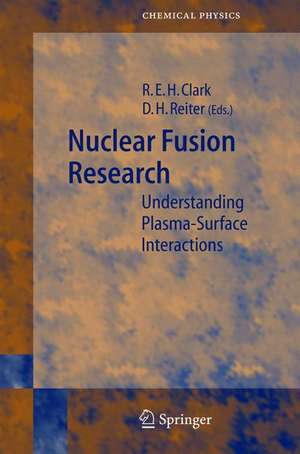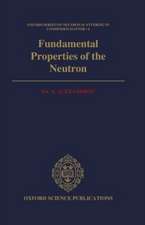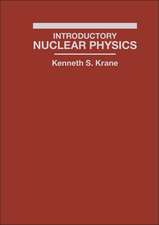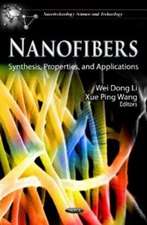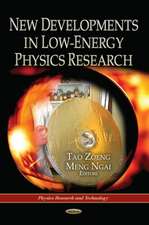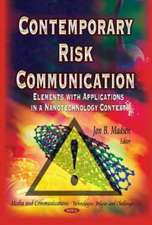Nuclear Fusion Research: Understanding Plasma-Surface Interactions: Springer Series in Chemical Physics, cartea 78
Editat de Robert E. H. Clark, Detlev Reiteren Limba Engleză Hardback – 18 feb 2005
| Toate formatele și edițiile | Preț | Express |
|---|---|---|
| Paperback (1) | 799.98 lei 39-44 zile | |
| Springer Berlin, Heidelberg – 19 oct 2010 | 799.98 lei 39-44 zile | |
| Hardback (1) | 958.38 lei 6-8 săpt. | |
| Springer Berlin, Heidelberg – 18 feb 2005 | 958.38 lei 6-8 săpt. |
Din seria Springer Series in Chemical Physics
- 20%
 Preț: 585.30 lei
Preț: 585.30 lei - 15%
 Preț: 643.00 lei
Preț: 643.00 lei - 15%
 Preț: 635.96 lei
Preț: 635.96 lei - 18%
 Preț: 953.03 lei
Preț: 953.03 lei - 15%
 Preț: 644.63 lei
Preț: 644.63 lei - 15%
 Preț: 638.43 lei
Preț: 638.43 lei - 15%
 Preț: 649.22 lei
Preț: 649.22 lei - 15%
 Preț: 647.40 lei
Preț: 647.40 lei - 15%
 Preț: 638.89 lei
Preț: 638.89 lei - 15%
 Preț: 652.31 lei
Preț: 652.31 lei - 15%
 Preț: 638.43 lei
Preț: 638.43 lei - 15%
 Preț: 637.13 lei
Preț: 637.13 lei - 18%
 Preț: 952.57 lei
Preț: 952.57 lei - 18%
 Preț: 947.85 lei
Preț: 947.85 lei - 15%
 Preț: 636.45 lei
Preț: 636.45 lei - 15%
 Preț: 649.87 lei
Preț: 649.87 lei - 18%
 Preț: 953.65 lei
Preț: 953.65 lei - 18%
 Preț: 894.03 lei
Preț: 894.03 lei - 15%
 Preț: 647.27 lei
Preț: 647.27 lei - 18%
 Preț: 1249.00 lei
Preț: 1249.00 lei - 15%
 Preț: 646.30 lei
Preț: 646.30 lei - 18%
 Preț: 954.14 lei
Preț: 954.14 lei - 24%
 Preț: 1226.82 lei
Preț: 1226.82 lei - 18%
 Preț: 961.72 lei
Preț: 961.72 lei - 18%
 Preț: 1002.31 lei
Preț: 1002.31 lei - 24%
 Preț: 647.25 lei
Preț: 647.25 lei - 18%
 Preț: 888.49 lei
Preț: 888.49 lei - 18%
 Preț: 908.04 lei
Preț: 908.04 lei - 15%
 Preț: 641.38 lei
Preț: 641.38 lei - 15%
 Preț: 585.40 lei
Preț: 585.40 lei - 15%
 Preț: 639.90 lei
Preț: 639.90 lei - 18%
 Preț: 897.02 lei
Preț: 897.02 lei
Preț: 958.38 lei
Preț vechi: 1168.76 lei
-18% Nou
Puncte Express: 1438
Preț estimativ în valută:
183.39€ • 196.10$ • 152.90£
183.39€ • 196.10$ • 152.90£
Carte tipărită la comandă
Livrare economică 17 aprilie-01 mai
Preluare comenzi: 021 569.72.76
Specificații
ISBN-13: 9783540230380
ISBN-10: 3540230386
Pagini: 484
Ilustrații: XX, 461 p. 210 illus., 6 illus. in color.
Dimensiuni: 155 x 235 x 35 mm
Greutate: 0.82 kg
Ediția:2005
Editura: Springer Berlin, Heidelberg
Colecția Springer
Seria Springer Series in Chemical Physics
Locul publicării:Berlin, Heidelberg, Germany
ISBN-10: 3540230386
Pagini: 484
Ilustrații: XX, 461 p. 210 illus., 6 illus. in color.
Dimensiuni: 155 x 235 x 35 mm
Greutate: 0.82 kg
Ediția:2005
Editura: Springer Berlin, Heidelberg
Colecția Springer
Seria Springer Series in Chemical Physics
Locul publicării:Berlin, Heidelberg, Germany
Public țintă
ResearchCuprins
Atomic and Surface Data Issues in Nuclear Fusion.- Plasma—Wall Interaction: Status and Data Needs.- Modeling of Fusion Edge Plasmas: Atomic and Molecular Data Issues.- Energy Deposition from ELMs in Fusion Devices.- Plasma Diagnostics.- Molecular Diagnostics of Cold Edge Plasmas.- Divertor Spectroscopy with Molecular Transport.- High-Temperature Plasma Edge Diagnostics.- X-ray Spectroscopy of High n Transitions of He- and Ne-Like Ions in Alcator C-Mod Plasmas.- High-Temperature Plasmas Diagnostics by X-ray Spectroscopy in the Low Density Limit.- Surface Processes and Material Issues.- Review and Status of Physical Sputtering and Chemical Erosion of Plasma Facing Materials.- Hydrogen Retention in and Release from Carbon Materials.- Interaction of Low-Energy Ions and Hydrocarbon Radicals with Carbon Surfaces.- Tritium Inventory in the Materials of the ITER Plasma-Facing Components.- Mixed and High-Z Plasma-Facing Materials in TEXTOR.- Beryllium and Liquid Metals as Plasma Facing Materials.- Databases.- IAEA Databases and Database Establishment Programs.- NIFS DATABASE and Cooperation with IAEA DCN.- The NIST Atomic Structure Databases.- The Atomic Data and Analysis Structure.- Collision Processes of Atomic and Molecular Hydrogen in Fusion Plasmas: The Cross-Section Data Status.- Partial and Differential Electron Impact Ionization Cross-Sections for Small Hydrocarbon Molecules.
Notă biografică
R. E. H. Clark is the Head of the Atomic and Molecular Data Unit of the International Atomic Energy Agency. He has an extensive background in the calculation of cross sections for electron impact excitation of atomic ions. He and co-workers at the Los Alamos National Laboratory have developed computational tools for the calculation of atomic structure and cross sections for excitation and ionization of atomic ions. These calculated data have been used in extensive modelling calculations of plasmas for a number of applications, including fusion energy research.
D. Reiter is a professor at the Institute for Laser and Plasmaphysics at Heinrich Heine University Düsseldorf, and at the Forschungszentrum Jülich, Germany. He and co-workers are the authors of the EIRENE Monte Carlo Code for atomic, molecular and surface processes in fusion plasmas, which is currently used in most fusion laboratories, including the international design team for the next step device ITER. His group also initiated and completed the first versions of the B2-EIRENE suit of codes, which, again, has become a standard tool for fusion edge plasma studies allowing to assess a consistent micro-macro model of plasma flow and atomic/molecular kinetics.
D. Reiter is a professor at the Institute for Laser and Plasmaphysics at Heinrich Heine University Düsseldorf, and at the Forschungszentrum Jülich, Germany. He and co-workers are the authors of the EIRENE Monte Carlo Code for atomic, molecular and surface processes in fusion plasmas, which is currently used in most fusion laboratories, including the international design team for the next step device ITER. His group also initiated and completed the first versions of the B2-EIRENE suit of codes, which, again, has become a standard tool for fusion edge plasma studies allowing to assess a consistent micro-macro model of plasma flow and atomic/molecular kinetics.
Textul de pe ultima copertă
It became clear in the early days of fusion research that the effects of the containment vessel (erosion of "impurities") degrade the overall fusion plasma performance. Progress in controlled nuclear fusion research over the last decade has led to magnetically confined plasmas that, in turn, are sufficiently powerful to damage the vessel structures over its lifetime. This book reviews current understanding and concepts to deal with this remaining critical design issue for fusion reactors. It reviews both progress and open questions, largely in terms of available and sought-after plasma-surface interaction data and atomic/molecular data related to these "plasma edge" issues.
Caracteristici
Outlines the remaining critical issues for controlled nuclear fusion Includes supplementary material: sn.pub/extras
